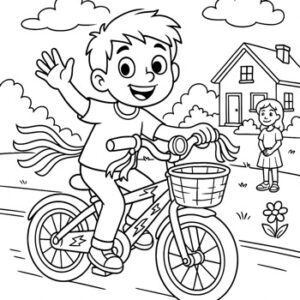
Question More, Action Knowledge.
Remember, at QMAK, we don’t just teach; we empower. We don’t just inform; we inspire. We don’t just question; we act. Become a Gold Member, and let’s unlock your child’s full potential, one question at a time.
Here you will find the resources that compliment the lessons taught during the month.
Songs are a great way to reinforce lessons in a fun, memorable way—by engaging musical and auditory learning styles, they help key ideas stick in children’s minds and support long-term retention well beyond the lesson.
Verse 1:
Got the latest phone in my hand
Already thinking ’bout the next big brand
That new app is calling my name
Though the old one works just the same
Like a magpie drawn to something bright
Can’t resist that new delight
Pre-Chorus:
But wait a minute, let me think this through
(Is it better just because it’s new?)
My attention’s like a butterfly
(Always ready for another try)
Chorus:
Shiny and new, shiny and new
Always chasing the next best thing
Before the old one’s even through
Like a spotlight in the night
Drawing moths into its light
Gotta learn to see what’s true
Beyond the shiny and new
Verse 2:
Starting hobbies left and right
Never sticking long enough to take flight
Download games I’ll never play
Chase trends that fade away
There’s that dopamine hit again
Making me forget where I’ve been
(Pre-Chorus)
(Chorus)
Bridge:
Sometimes the best things
(Take time to grow)
Like gardens that need
(Time to show)
The beauty that comes
When we stay long enough
To let the familiar
Show us its stuff!
Chorus:
Shiny and new, shiny and new
Learning when to chase and when to stay
Finding balance in what we do
‘Cause sometimes old and true
Is better than shiny and new
Gotta learn to see what’s true
Beyond the shiny and new
Outro:
(Spoken with wisdom)
Remember friends
Not everything needs an upgrade
Sometimes the real treasure
Is right where you are
Having your child complete this coloring page right after reading the story helps transition the lesson from imaginative reading to creative expression, turning their thoughts into a vibrant work of art.
Color-In Picture

Movies are a great tool for engaging visual and auditory learners, and when paired with comprehension quizzes, they encourage active viewing—helping children process and retain key concepts rather than just being passively entertained.
Moana provides a vibrant exploration of novelty bias through the story of a young leader drawn to explore beyond her island’s reef.
Through Moana’s irresistible attraction to the ocean despite her community’s warnings, students witness how our innate curiosity about new things can drive innovation and discovery.
The film demonstrates novelty bias through Moana’s constant pull toward the unknown – from collecting seashells as a toddler to ultimately becoming a master wayfinder – showing how attraction to novelty can lead to breakthrough solutions when existing systems fail.
As viewers follow her journey to restore the heart of Te Fiti, they see how her natural draw toward new experiences helps her discover lost knowledge about her people’s voyaging heritage and find creative solutions to her island’s environmental crisis.
Through its celebration of exploration and discovery, the film shows how novelty bias, when properly channeled, can become a powerful force for positive change, pushing us to look beyond comfortable but limiting boundaries to find answers in unexpected places.
1. How does young Moana’s attraction to seashells and the ocean demonstrate novelty bias in its earliest form?
a) She’s simply following her father’s instructions
b) She’s naturally drawn to explore new and unfamiliar elements in her environment
c) She’s trying to disobey island rules
d) She’s practicing for her future role as chief
2. What role does novelty bias play in Moana’s decision to venture beyond the reef, despite her community’s established rules?
a) It compels her to seek new solutions to her island’s problems
b) It makes her ignore all traditional wisdom
c) It forces her to abandon her duties as future chief
d) It has no influence on her decision
3. How does Moana’s attraction to novelty differ from Maui’s approach to problem-solving initially?
a) Maui relies solely on his past experiences and known powers
b) Moana is afraid of new experiences while Maui embraces them
c) They both avoid novel solutions equally
d) They share the exact same approach to new situations
4. In what way does Moana’s novelty bias contribute to discovering her people’s lost wayfinding heritage?
a) It makes her ignore all traditions
b) It drives her to explore ancient caves and learn forgotten stories
c) It prevents her from understanding her culture
d) It has no connection to this discovery
5. How does the village’s resistance to exploration represent the opposite of novelty bias?
a) It shows a preference for familiar, established patterns
b) It demonstrates forward-thinking leadership
c) It represents progressive thinking
d) It shows attraction to new ideas
6. When Moana discovers the hidden boats of her ancestors, how does her novelty bias interact with traditional knowledge?
a) She completely rejects the traditional boats
b) She combines her love of new experiences with her ancestors’ wisdom
c) She ignores the discovery entirely
d) She fears the ancient technology
7. How does Moana’s novelty bias help her approach Te Kā differently in the final confrontation?
a) She simply uses brute force
b) She relies only on Maui’s help
c) She sees beyond the monster to discover Te Fiti’s true identity
d) She follows the traditional way of fighting
8. What role does novelty bias play in Moana’s ability to restore her people’s voyaging tradition?
a) It prevents her from learning navigation
b) It helps her embrace and revive the unfamiliar practice of wayfinding
c) It makes her reject all traditional practices
d) It has no impact on her learning
9. How does Moana’s novelty bias influence her leadership style by the end of the film?
a) She completely rejects island traditions
b) She maintains strict isolation of the island
c) She integrates both exploration and tradition
d) She follows exactly in her father’s footsteps
10. What does Moana’s journey suggest about the relationship between novelty bias and innovation?
a) Novelty bias always leads to poor decisions
b) Innovation only comes from following traditions
c) Novelty bias can drive discovery and creative problem-solving
d) New ideas should always be rejected
1. b
2. a
3. a
4. b
5. a
6. b
7. c
8. b
9. c
10. c
This beautifully illustrated book delivers a message of self-acceptance, self-love, and the inherent worth of every individual. Through simple, affirming statements, the book encourages children to embrace their unique qualities, celebrate diversity, and recognize that they are enough just as they are.
By engaging with this empowering and uplifting story, children can develop a stronger sense of self-esteem, resilience, and connection to others, while learning to let go of limiting self-definitions and embrace their boundless potential.
1. What is the main message of the book?
a) You should try to be like others
b) You are valuable just as you are
c) Only certain people are enough
d) You need to change to be accepted
2. In the book, what is the girl compared to when standing tall?
a) A mountain
b) A skyscraper
c) A tree
d) A giraffe
3. What does the book say about the girl’s voice?
a) It should be quiet
b) It’s meant to be heard
c) It’s not important
d) It should sound like others
4. How does the book describe the girl’s ability to learn?
a) She can’t learn new things
b) She should only learn easy things
c) She can learn anything
d) Learning isn’t important
5. What does the book say about helping others?
a) It’s a waste of time
b) Only help those who can help you back
c) Helping others is part of who we are
d) Don’t help anyone
6. How does the book describe the girl’s relationship with nature?
a) She’s afraid of nature
b) She’s part of nature
c) Nature is unimportant
d) She should avoid nature
7. What does the book say about the girl’s dreams?
a) Dreams are silly
b) Only some dreams matter
c) Her dreams are meant to be chased
d) She shouldn’t have dreams
8. How does the book describe differences between people?
a) Differences are bad
b) Everyone should be the same
c) Differences make us special
d) Only some differences are okay
9. What does the book say about the girl’s ability to stand up for herself?
a) She shouldn’t stand up for herself
b) Only adults can stand up for themselves
c) She can stand up for herself
d) Standing up for yourself is wrong
10. How does the book end?
a) With the girl feeling sad
b) With the girl wanting to be someone else
c) With the girl knowing she is enough
d) With the girl giving up
1. b) You are valuable just as you are
2. c) A tree
3. b) It’s meant to be heard
4. c) She can learn anything
5. c) Helping others is part of who we are
6. b) She’s part of nature
7. c) Her dreams are meant to be chased
8. c) Differences make us special
9. c) She can stand up for herself
10. c) With the girl knowing she is enough
Setting mindful lessons like “The Erasing Game” to music creates a powerful tool for children to explore their core identity beyond labels and definitions, helping them internalize the profound concept that their essential self exists independently of external descriptions. A song’s memorable melody and rhythm transform abstract philosophical ideas about being and identity into an accessible, joyful experience that children can carry with them, reinforcing their inherent worth and providing a comforting reminder of their unchanging essence whenever they face questions about who they truly are.
Verse 1:
Write it down, then erase it clean
“I am” is more than what it seems
Add a word, then take it away
Who are you at the end of the day?
Pre-Chorus:
I am strong, I am shy
I am short, I am high
Erase it all, and what do you see?
Just “I am”, that’s the key
Chorus:
I am, I am, two words so small
Yet they contain it all
Write and erase, again and again
I am, I am, where we begin
Verse 2:
I’m a student, I’m a friend
I’m an artist, without end
But when those words fade away
“I am” is all that’s here to stay
(Pre-Chorus)
(Chorus)
Bridge:
Beyond the labels, beyond the names
We’re playing the Erasing Game
Finding the essence of who we are
Two words that take us near and far
(Chorus)
Outro:
Open your eyes, what do you know?
You’re more than the words that come and go
I am, you are, we all can be
Whatever we choose, eternally

Remember, at QMAK, we don’t just teach; we empower. We don’t just inform; we inspire. We don’t just question; we act. Become a Gold Member, and let’s unlock your child’s full potential, one question at a time.